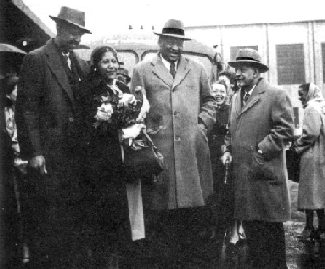
No Easy Victories: African Liberation and American Activists over a Half Century, 1950-2000
Gail Hovey, and Charles Cobb Jr.
Published by Africa World Press.
home
|
No Easy Victories: African Liberation and American Activists over a Half Century, 1950-2000 |
Edited by William Minter, Gail Hovey, and Charles Cobb Jr. Published by Africa World Press. |
|
An Unfinished Journey by William Minter The 1950s: Africa Solidarity Rising by Lisa Brock The 1960s: Making Connections by Mimi Edmunds
The 1970s: Expanding Networks by Joseph F. Jordan
The 1980s: The Anti-Apartheid Convergence by David Goodman
|
Featured TextThe following text is excerpted from No Easy Victories for web presentation on noeasyvictories.org. This text may be freely reproduced if credit is given to No Easy Victories. Please mention that the book is available for order on-line at http://noeasyvictories.org and http://africaworldpressbooks.com. Chapter 2, The 1950s: Africa Solidarity Risingby Lisa Brock From pages 59-61. Chapter continues on pages 62-72. | pdf of complete Chapter 2 (1.3M) 
Photo: As the Cold War intensified, the Council on African Affairs was attacked as subversive and its leader, Alphaeus Hunton, was jailed for nine months in 1951. On his release, Hunton, left, was welcomed by his wife Dorothy, Paul Robeson, and W. E. B. Du Bois. Photo reproduced from Hunton 1986. In the summer of 1979, I attended my first demonstration in solidarity with the people of Africa. Little did I know that this would be the first of many such actions, or that out of it would grow my intellectual and political work for the next 20 years. The Southern Africa Support Project in Washington, DC called the demonstration to protest the presence in Washington of Bishop Abel Muzorewa. Recently installed as leader of what was briefly called Zimbabwe-Rhodesia, Muzorewa was in town to gain support for his government, which had been established to forestall genuine majority rule in Zimbabwe. Even before, I had been involved in domestic antiracist issues, as a student at Howard University and as a member of the National Alliance Against Racist and Political Repression. I had begun to see the connections between the local and the global, especially in terms of racism, sexism, power, and imperialism. Meeting Dennis Brutus, while I was a graduate student at Northwestern University, solidified my growing sense of internationalism with concrete action. It was at Dennis's urging that I became a co-chair in Chicago of the Stop the Apartheid Rugby Tour in 1981, and I never looked back. I came to understand that I was part of a tradition of activists and intellectuals who had made that same political and personal journey. In this chapter about the 1950s, I will present three "lions," activists who preceded me on this journey and emerged as leaders: George Houser, Bill Sutherland, and Charlene Mitchell. For each of them, but in very different ways, the 1950s was a determining decade that shaped the work they would engage in for the next half century. From the vantage point of the twenty-first century, it is important to grasp that the 1950s was a messy dance of a decade. The Cold War was omnipresent, both shaping and being shaped by rising demands for freedom and civil rights on the African continent and in the United States. The struggles against racism, colonialism, and nuclear proliferation were intertwined. Enormous, almost impossible, hopes and dreams were placed on Africa and African leaders by Americans, especially African Americans, who wanted to believe that colonialism and racial oppression were finite and vulnerable. As I began to explore the 1950s, probably most revelatory for me was the discovery that virtually all U.S.-centered activists and scholars whom we identify with the civil and human rights movements consciously saw themselves as working in solidarity with the peoples of Africa. The list is far too long to name in full but includes Paul and Essie Robeson, St. Clair Drake, Thurgood Marshall, Sidney Poitier, Ella Baker, Billie Holiday, and Harry Belafonte. This discovery reinforced the need for the sort of history we present here, and it raised important questions. Why are the histories, documentaries, and biographies of these people and this era problematically constructed to emphasize the national and not the international? How does the desire for a "national narrative" obscure the evolution of an international one? Could this be one postmodern undertaking of scholar activists, to deconstruct the "imagined past" toward a reimagined future? This small essay dreams so.
Race, Ideology, and the Fall of the Council on African AffairsBefore I present the lives and work of George Houser, Bill Sutherland, and Charlene Mitchell, a few words should be said about the Council on African Affairs. The council closed its doors in the mid-1950s, just as Houser's American Committee on Africa was opening up for business. Formed in 1937, the Council on African Affairs was by the 1950s the largest Africa solidarity organization in the United States up to that time. Its history illustrates the power of African American solidarity with the peoples of Africa as well as the threat this solidarity posed to the American establishment. At the beginning of World War II the organization was "crafted by the left" but embraced by "the full range of black American liberals, church leaders, [and the] professional and middle class" (Von Eschen 1997, 19), as well as by black nationalist organizations. At its height, under the leadership of giants like Paul Robeson, W. E. B. Du Bois, and Alphaeus Hunton, the council had the ear of the U.S. president and drew tens of thousands to mass rallies at Madison Square Garden and Harlem's Abyssinian Baptist Church. From its office on 26th Street in New York City, the council linked the struggle against racism in the United States with the colonization of "colored peoples" the world over. Guests from South Africa and India were honored at its events. CAA campaigns-- opposing Mussolini's invasion of Ethiopia; advocating for a strong United Nations; championing workers' causes in South Africa, Nigeria, and Ghana; demanding the end of the South African mandate over South West Africa--were widely applauded in U.S., European, and African newspapers. The council in the late 1940s had varied and deep personal, political, and journalistic ties in Africa, India, the Caribbean, and Europe. By 1952, however, the liberal-left coalition was imploding under the weight of a totalizing Cold War. Robeson and Du Bois were hounded by U.S. authorities and Hunton served nine months in jail in 1951 for his political and ideological beliefs. Labeling them as subversive and soft on communism was both accurate and effective, and it cost the council considerable support. While none professed membership in the Communist Party at the time, all three men were clearly Marxist or left-leaning. And all three refused to distance themselves from friends and comrades in the U.S. Communist Party or from their belief in a détente between the Soviet Union and the United States. Choices had to be made. At the end of the war, President Truman had indicated that he was ready to concede certain civil rights demands. But these concessions were predicated on black leadership support for, or at least acquiescence to, U.S. domestic and foreign policy. While this kind of "contradictory politics of inclusion" was not new for African Americans, the stakes were higher in postwar America (Brock 1998). This was so, ironically, because organizations like the CAA and a radicalized NAACP as well as the black media had brought international attention to the horrors of Jim Crow. Engaged in a deepening ideological struggle with the Left, the United States was touting itself as moral leader of the free world. Yet the United States had an image problem, and this problem became especially acute as old colonial relations in Africa began to fall away and countries moved toward independence. Taking the offensive, the Truman administration set out to craft an Africa policy for the United States and to recruit American blacks to play a role in these new initiatives. This was a game two could play. Leading black liberal groups--the NAACP, the Urban League, the National Council of Negro Women--employed a carrot and stick of their own. If the government desegregated the armed forces, for instance, they would not demonstrate in Washington; if the government appointed blacks to key government, judicial, labor, and military positions, the black press would applaud U.S. programs such as the Marshall Plan in Europe. More African Americans than ever before (although still only a handful) emerged to play roles on the national and international stage. Ralph Bunche, an early supporter of the CAA, became the U.S. representative at the United Nations and won a Nobel Peace Prize. Max Yergan, one of the original founders of the CAA, turned to the far right and even collaborated with the FBI against the CAA. Edith Sampson, a prominent attorney from Chicago, became the first African American federal judge, while Maida Springer, a union organizer, served as the AFL-CIO's African representative for many years. All of these African Americans became at one time or another part of U.S. State Department tours that traveled abroad to "reassure Africans and Asians that the U.S. government treated [black Americans] fairly" (Lutz 2001, 328). This was one aspect of the messy dance mentioned above. African Americans hoped their involvement in these international jaunts would lead to increased justice at home, while the U.S. government encouraged and promoted a black presence on such tours in hopes of pushing its own corporate, political, and economic goals in Africa. Although the Council on African Affairs was harassed and charged with sedition, it refused to back off of its critique of race relations in the United States, where segregation and white-on-black violence continued. Nor would it uncritically support an emerging U.S. policy in Africa. The CAA moved its office to the more friendly environs of 125th Street in Harlem. It was the only U.S. organization in the early 1950s to offer an incisive analysis of the two major trends in Africa at that time: first, the deepening African anticolonial/antiracist struggles, and second, the desperate attempts by colonial powers to retain control. The council paid a price for its clear questions and straightforward analysis. In October 1954, Alphaeus Hunton was subpoenaed to appear before a federal grand jury and was forced to surrender all records detailing the CAA's relationship with the African National Congress and the South African Indian Congress. The CAA's newsletter, Spotlight on Africa, reported that the grand jury sought to determine "whether these activities represented a violation of the Foreign Agents Registration Act" (October 28, 1954). One of Hunton's last involvements before closing the Council on African Affairs was to attend the Asian African Conference in Bandung, Indonesia. Although he criticized the conference for not having enough African participation, he clearly identified with the Cold War weariness in the "colored" world that motivated them to find their own nonaligned path. "It is possible and practicable," he said, "for Communist, non-Communist and anti-communist to live together, meet together, speak together, and contribute toward the common good of all mankind" (Von Eschen 1997, 172). Continued on pages 62-72. Order book. |
This page is part of the No Easy Victories website.